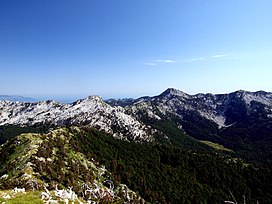
Back Dinariese Alpe Afrikaans جبال الألب الدينارية Arabic Дынарскае нагор’е Byelorussian Дынарскае сугор’е BE-X-OLD Динарски планини Bulgarian Dinaridi BS Alps Dinàrics Catalan Dinaric Alps CEB Dinárské hory Czech Alpau Dinarig Welsh
| Dinaric Alps | |
|---|---|
 Orjen spreads between Bosnia and Herzegovina and Montenegro and is the most heavily karstified range of the Dinarides. | |
| Highest point | |
| Peak | Maja Jezercë in Albania |
| Elevation | 2,694 m (8,839 ft) |
| Coordinates | 45°N 17°E / 45°N 17°E |
| Dimensions | |
| Length | 645 km (401 mi) NW-SE |
| Area | 200,000 km2 (77,000 sq mi) |
| Geography | |
| Countries | Albania, Bosnia and Herzegovina, Croatia, Italy, Montenegro, Kosovo, Serbia and Slovenia |
| Borders on | Julian Alps |
| Geology | |
| Age of rock | Mesozoic era |
| Type of rock | Sedimentary |
The Dinaric Alps (/dɪˈnærɪk/),[1] also Dinarides, are a mountain range in Southern and Southcentral Europe, separating the continental Balkan Peninsula from the Adriatic Sea. They stretch from Italy in the northwest through Slovenia, Croatia, Bosnia and Herzegovina, Serbia, Montenegro, and Kosovo to Albania in the southeast.[2][3]
The Dinaric Alps extend for approximately 645 kilometres (401 mi) along the western Balkan Peninsula from the Julian Alps of the northeast Italy, downwards to the Šar and Korab massif, where their direction changes. The Accursed Mountains are the highest section of the entire Dinaric Alps; this section stretches from Albania to Kosovo and eastern Montenegro. Maja Jezercë is the highest peak and is located in Albania, standing at 2,694 metres (8,839 ft) above the Adriatic.
The Dinaric Alps are one of the most rugged and extensive mountainous areas of Europe, alongside the Caucasus Mountains, Alps, Pyrenees, Carpathian Mountains and Scandinavian Mountains.[citation needed] They are formed largely of Mesozoic and Cenozoic sedimentary rocks of dolomite, limestone, sandstone and conglomerates formed by seas and lakes that once covered the area. During the Alpine earth movements that occurred 50 to 100 million years ago, immense lateral pressures folded and overthrust the rocks in a great arc around the old rigid block of the northeast. The main tectonic phase of the orogenesis in the area of the Dinaric Karst took place in Cenozoic Era (Paleogene) as a result of the Adriatic Microplate (Adria) collision with Europe, and the process is still active.[4] The Dinaric Alps were thrown up in more or less parallel ranges, stretching like necklaces from the Julian Alps as far as northern Albania and Kosovo, where the mountainous terrain subsides to make way for the waters of the Drin River and the plains of Kosovo.
- ^ "Dinaric". Oxford English Dictionary (Online ed.). Oxford University Press. (Subscription or participating institution membership required.)
- ^ Profile, dictionary.reference.com; accessed 25 August 2015.
- ^ "Visit Dinaric Alps".
- ^ Korbar, Tvrtko (2009). "Orogenic evolution of the External Dinarides in the NE Adriatic region: A model constrained by tectonostratigraphy of Upper Cretaceous to Paleogene carbonates". Earth-Science Reviews. 96 (4): 296–312. Bibcode:2009ESRv...96..296K. doi:10.1016/j.earscirev.2009.07.004.
© MMXXIII Rich X Search. We shall prevail. All rights reserved. Rich X Search
